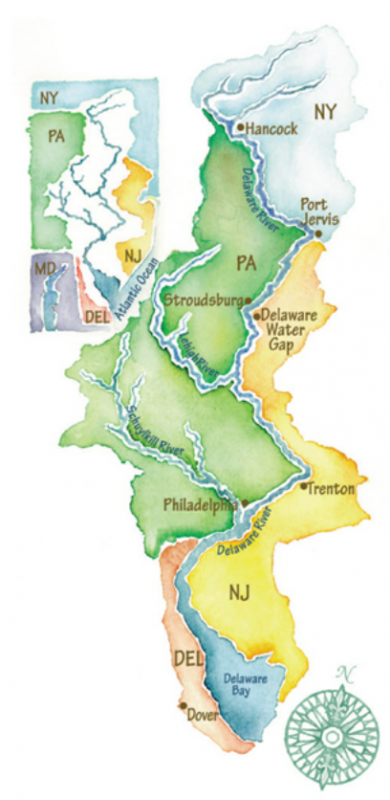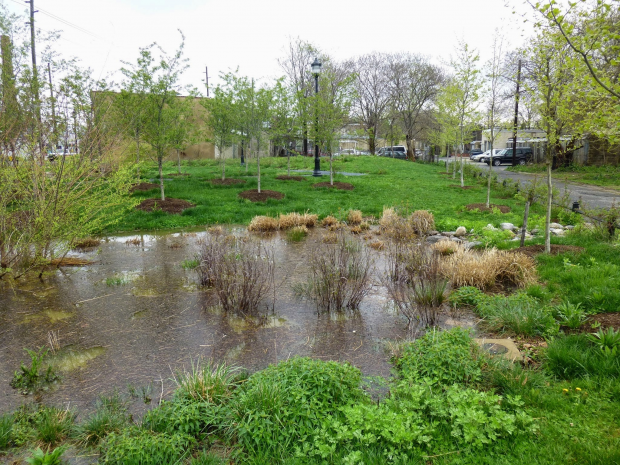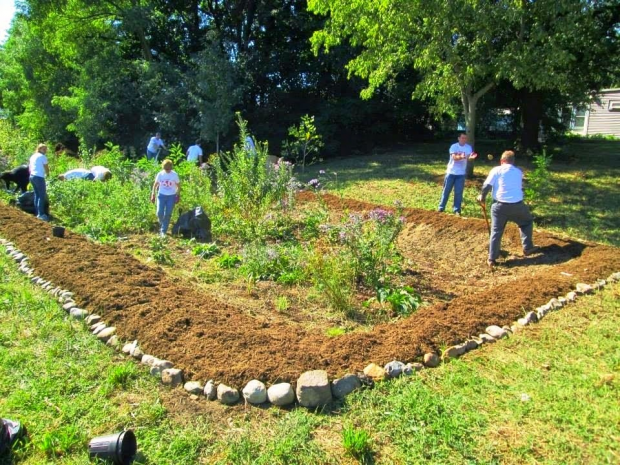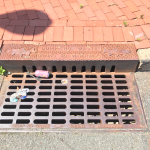New Jersey Future Blog
Green Infrastructure in the Garden State: Stormwater Research in the Delaware River Watershed
September 20th, 2023 by Brooke Schwartzman
In 2020, the New Jersey Department of Environmental Protection (NJDEP) updated the Stormwater Management Rules, which now require that municipalities incorporate green infrastructure into major development projects. In many areas of the state, this relatively new policy change has meant a significant departure from the way that stormwater management was approached previously. New Jersey Future (NJF) sought to explore the impact of the rule change on green infrastructure implementation in New Jersey’s Delaware River Watershed region.
Stormwater is water that accumulates on land either through rain or snow, but instead of soaking into the ground as it would in nature, it accumulates into stormwater runoff. Poorly managed stormwater can result in a host of negative consequences like flash flooding and water quality issues caused by nonpoint source pollution. Green infrastructure (GI) is a solution to addressing stormwater runoff. This umbrella term includes any structure or installation that manages stormwater by protecting, restoring, or mimicking the natural water cycle. Consequently, GI decreases impervious cover and the stress on outdated stormwater infrastructure and effectively filters said water before inundating it back into the ground.
New Jersey has several regulatory structures in place to control stormwater as part of the National Pollutant Discharge Elimination System (NPDES). One such structure is N.J.A.C. 7:8, commonly known as the Stormwater Management Rules, which requires municipalities to hold a Municipal Separate Storm Sewer System (MS4) permit. Municipalities receive the MS4 permit after developing a stormwater program and meeting Statewide Basic Requirements (SBR) which set minimum standards for controlling stormwater pollution and inundation. One of the SBRs is for municipalities to develop a Stormwater Control Ordinance (SCO) that codifies compliance with N.J.A.C. 7:8. The SCO is then applied to all major development and redevelopment projects within the municipality. When NJDEP makes an amendment to their Stormwater Management Rules, municipalities are required to reflect that update in their SCOs within one year of the effective changes. Stormwater data for all NJ municipalities is available online through Jersey WaterCheck.

The Delaware River Basin. Source: Delaware River Basin Commission
In spite of its many benefits, green infrastructure is still underutilized in New Jersey. NJDEP sought to address this by making changes to the Stormwater Management Rules in 2020 that officially took effect in March 2021. The biggest difference between the Stormwater Management Rules then and now is how SCOs are expected to regulate GI. Prior, the minimum amount of GI that SCOs had to have demanded was “the maximum extent practicable”, leaving loopholes for the installation of green infrastructure. Now, SCOs require that GI be used for every major development project. Additionally, as part of New Jersey Protecting Against Climate Threats (NJ PACT), updates to the stormwater management rules went into effect on July 17, 2023, due to the Inland Flood Protection Rules. Further updates are expected as part of Resilient Environments and Landscapes (REAL). NJDEP released a model stormwater ordinance to guide municipalities as they amend their SCOs. This ordinance uses minimum standards but municipalities are free to make those standards stricter. NJF released their own enhanced model stormwater ordinance in 2021 to demonstrate ways in which municipalities could go above and beyond minimum requirements, such as including the definition of minor development and reducing the threshold for major development in their SCO. Municipalities that implement an enhanced model ordinance are eligible for Sustainable Jersey points.
New Jersey Future wanted to understand how the updated SCOs are impacting the implementation of green infrastructure, specifically in the Delaware River Watershed. The Delaware River Watershed is an interesting case study because it intersects with over 200 municipalities in New Jersey and several other states. 30 municipalities were selected for outreach. Communities were more likely to be targeted if they had populations especially vulnerable to flooding impacts, had certain kinds of infrastructure present suitable for complete and green streets, or were located in certain ecological regions. 27 of the 30 researched municipalities have updated their SCO and posted it online. Only one municipality, Edgewater Park Township, adopted above-minimum stormwater requirements language in their SCO. Note that even though a municipality adopted the minimum requirements language it does not necessarily mean they are installing the minimum amount of GI, as evidenced by Camden later in this article. Of the 30, NJF interviewed 10 municipalities.
Several overall trends were revealed when analyzing the municipalities’ responses. Small municipalities were less likely than large ones to require GI prior to the rule change, but almost all municipalities regardless of size already had GI present. The most common types of green infrastructure implemented are retention and infiltration basins, rain gardens, tree plantings, and permeable cover. Some municipalities have incorporated the impacts of the updated SCO into their master plan. Most are still in the process of building their stormwater infrastructure maps, another new requirement of the updated Stormwater Management Rules. All 10 municipalities interviewed are working with outside consultants for the task. Most municipalities have approved little to no projects under the new SCO either because there is little new development going on or because current projects are legacied under the previous rules. The municipalities that engaged stakeholders about GI did so primarily through regular council meetings; there have been a range of reactions from the general public. By far the most common barrier to meeting the new SCO requirements cited was funding even though most of the municipalities had already received stormwater grants from NJDEP. It also became clear through NJF’s interactions with municipalities that many have limited capacity to handle the additional work that is born out of implementing the updated SCO, which demonstrates that additional technical assistance is needed.

Waterfront South Rain Garden, Camden. Source: Rutgers GIS web map of Camden Green Infrastructure Projects
One municipality that is a good example of what it means to build an expansive green infrastructure system is the City of Camden. Even though Camden’s SCO is using the minimum requirements language set by NJDEP, the city’s actions have gone far beyond that. The city takes part in the Camden SMART initiative founded in 2011 and is made up of several organizations and stakeholder groups including Camden Community Partnership (CCP), the City of Camden (City), Camden County Municipal Utilities Authority (CCMUA), Rutgers Cooperative Extension Water Resources Program (RCE), New Jersey Tree Foundation (NJTF), and the NJ Department of Environmental Protection (NJDEP). Camden SMART is responsible for at least 50 GI projects. The city is filled with tree plantings, rain gardens, stormwater planters and rain barrels. Over 60 million gallons of stormwater have thus far been captured. Between the additional GI projects coming up and the new street bump outs and green curb lines that will be installed as a response to the new SCO requirements, the city aims to eventually capture 30 million gallons annually. Camden is also adept at engaging community members via regular city-wide meetings on upcoming GI projects, sustainability events, community rain gardens, and rain barrel workshops. Two challenges face Camden in the expansion of their GI network: the large amount of impervious surfaces and lack of available space, and litter which has the potential to interrupt the water inundation cycle if too much accumulates in green infrastructure installments. To learn more about how Camden is leading the charge in green infrastructure, visit their interactive map of GI projects.

29th Street Biobasins, Camden. Source: Rutgers GIS web map of Camden Green Infrastructure Projects
The changes made by NJDEP to the Stormwater Management Rules bring New Jersey one step closer to achieving climate resilience. Municipalities are working toward incorporating the amendments into their SCOs, but are in need of more support. One strategy to increase dedicated stormwater management funding is to explore the implementation of a stormwater utility. The increased workload and expenses associated with the initiative put additional strain on municipalities. In spite of these challenges, places like Camden demonstrate how powerful green infrastructure can be when local leaders are committed to its installation.
Related Posts
Tags: basin, flood mitigation, flooding, funding, green infrastructure, municipalities, Stormwater, stormwater management, stormwater management rules
















